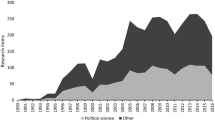Abstract
In this paper we use a simple Downsian spatial model to analyze the properties of campaign contributions. We first consider campaign contributions that are intended to inform voters of candidate positions. We show that it is difficult to construct arguments in a Downsian spatial model for why some voters would choose to contribute to a candidateand the candidate would want to spend the money contributed to inform voters of his position. We then define persuasive campaign expenditures as those that are intended to convince an individual to vote for a candidate regardless of the candidate's position on issues. In the presence of persuasive campaign expenditures some voters have an incentive to contribute to one or both candidates, and the candidates have an incentive to spend the money. We show why the nature of persuasive campaign expenditures may explain both their growth in recent years and the increasing advantage of incumbency.
Similar content being viewed by others
References
Asher, H.B. (1983). Voting behavior research in the 1980s: An examination of some old and new problem areas. In A.W. Finifter (Ed.),Political science: The state of the discipline, 339–388. Washington, DC: American Political Science Association.
Austen-Smith, D. (1987). Interest groups, campaign contributions, and probabilistic voting.Public Choice 54: 123–139.
Baron, D.P. (1989). Service-induced campaign contributions and the electoral equilibrium.Quarterly Journal of Economics 104: 45–72.
Ben-Zion, U. and Eyton, Z. (1974). On money, votes, and policy in a democratic society.Public Choice 17: 1–10.
Block, H. (1974). Advertising and profitability: A reappraisal.Journal of Political Economy 82: 541–548.
Cooper, K.J. and Pinnin, E. (1992). Retirements from House reach 50.Washington Post 22 April: A1ff.
Coughlin, P. and Nitzan, S. (1981a). Electoral outcomes with probabilistic voting and Nash social welfare maxima.Journal of Public Economics 15: 113–122.
Coughlin, P. and Nitzan, S. (1981b). Directional and local electoral equilibria with probabilistic voting.Journal of Economic Theory 24: 226–239.
Davis, O.A., DeGroot, M.H. and Hinich, M.J. (1972). Social preference orderings and majority rule.Econometrica 40: 147–157.
Davis, O.A., Hinich, M.J. and Ordeshook, P.C. (1970). An expository development of a mathematical model of the electoral process.American Political Science Review 64: 426–448.
Denzau, A. and Munger, M. (1986). Legislators and interest groups: How unorganized interests get represented.American Political Science Review 80: 89–106.
Downs, A. (1957).An economic theory of democracy. New York: Harper and Row.
Enelow, J.M. and Hinich, M.J. (1984).The spatial theory of voting. Cambridge: Cambridge University Press.
Grabowski, H.G. and Mueller, D.C. (1978). Industrial research and development, intangible capital stock, and firm profit rates.Bell Journal of Economics 9: 328–343.
Hinich, M.J., Ledyard, J.O. and Ordeshook, P.C. (1972). Nonvoting and the existence of equilibrium under majority rule.Journal of Economic Theory 4: 144–153.
Hinich, M.J. and Munger, M. (1989). Political investment, voter perceptions, and candidate strategy: An equilibrium spatial analysis. In P.C. Ordeshook (Ed.),Models of strategic choice in politics. Ann Arbor, MI.: University of Michigan Press.
Jacobson, G.C. (1980).Money in congressional elections. New Haven: Yale University Press.
Jacobson, G.C. and Kernell, S. (1983).Strategy and choice in congressional elections. New Haven: Yale University Press.
Kinder, D.R. and Abelson, R.P. (1981). Appraising presidential candidates: Personality and affect in the 1980 campaign. Paper presented at theAPSA meetings, New York, NY.
Ledyard, J.O. (1984). The pure theory of large two-candidate elections.Public Choice 44(1): 7–41.
Lott Jr., J.R. (1986). Brand names and barriers to entry in political markets.Public Choice 51(1): 87–92.
Mayhew, D.R. (1974a).Congress: The electoral connection. New Haven: Yale University Press.
Mayhew, D.R. (1974b). Congressional elections: The case of the vanishing marginals.Polity 6: 295–317.
Mickelson, S. (1989).From whistle stop to sound bite. New York: Praeger.
Morton, R. and Cameron, C. (1991). Elections and the theory of campaign contributions: A survey and critical analysis. Nicholls State University. Mimeo.
Mueller, D.C. (1989).Public choice II. Cambridge: Cambridge University Press.
Nelson, P. (1976). Political information.Journal of Law and Economics 19(August): 315–336.
Norrander, B. (1986). Correlates of vote choice in the 1980 presidential primary.Journal of Politics 48(February): 156–166.
Ordeshook, P.C. (1986).Game theory and political theory. Cambridge: Cambridge University Press.
Plott, C.R. (1967). A notion of equilibrium and its possibility under majority rule.American Economic Review 57: 787–806.
Pomper, G.M. (1988).Voters, elections, and parties. New Brunswick: Transaction Books.
Poole, K.T. and Romer, T. (1985). Patterns of political action committee contributions to the 1980 campaigns for the United States house of representatives.Public Choice 47(1): 63–111.
Porter, M.E. (1974). Consumer behavior, retailer power and market performance in consumer goods industries.Review of Economics and Statistics 56: 419–436.
RePass, D.E. (1971). Issue salience and party choice.American Political Science Review 65: 389–400.
Snyder, Jr., J.S. (1990). Campaign contributions as investments: The U.S. house of representatives 1980–86.Journal of Political Economy 98: 1195–1227.
Stokes, D.E. (1963). Spatial models of party competition.American Political Science Review 57: 368–377.
Stokes, D.E. and Miller, W. (1962). Party government and the saliency of congress.Public Opinion Quarterly 26: 631–646.
Swerdlow, J.L. (Ed.) (1988).Media technology and the vote. Boulder, CO: Westview Press.
Tullock, G. (1967).Toward a mathematics of politics. Ann Arbor: University of Michigan Press.
Weiss, L.W. (1969). Advertising, profits, and corporate taxes.Review of Economics and Statistics 51: 421–430.
Welch, W.P. (1974). The economics of campaign funds.Public Choice 20: 83–97.
Welch, W.P. (1976). The effectiveness of expenditures in state legislative races.American Politics Quarterly 4: 333–356.
Will, G.F. (1992). So much for the scourge of the status quo.Washington Post (26 April): C7.
Yen, S.T., Coats, R.M. and Dalton, T.R. (1992). Brand-name investment of candidates and district homogeneity: An ordinal response model.Southern Economic Journal 58(April): 988–1001.
Author information
Authors and Affiliations
Rights and permissions
About this article
Cite this article
Mueller, D.C., Stratmann, T. Informative and persuasive campaigning. Public Choice 81, 55–77 (1994). https://doi.org/10.1007/BF01053266
Accepted:
Issue Date:
DOI: https://doi.org/10.1007/BF01053266




